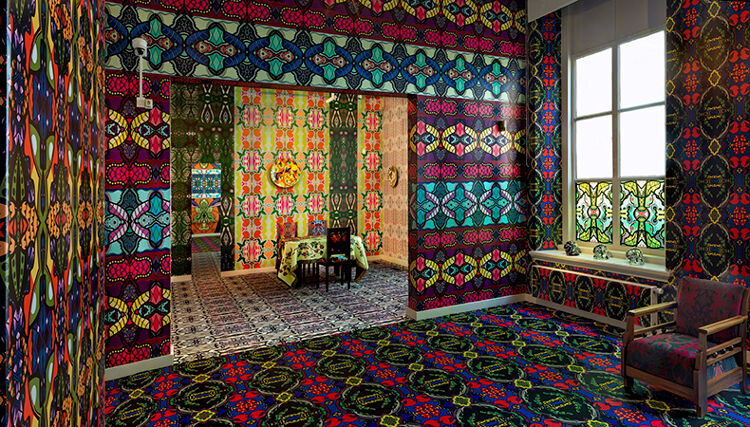Celebrating talent in the Associations Pavilion at FESPA Global Print Expo 2022: Netherlands to UK

The Associations Pavilion at the FESPA Global Expo 2022 (31 May–3 June), located at the Messe Berlin, will offer members the opportunity to showcase samples of their work both digitally and screen printed. Visitors to the exhibition will learn how diverse applications were printed and finished by members from 20 countries.
Netherlands (FESPA Nederland Association)

Nouveau deco
This was a challenging all-in-one project to “dress up” the inside and outside of the Stedelijk Museum in Kampen with beautiful nouveau deco patterns by artist Christie van der Haak.
The entire print was digitally mapped and supplied patterns were pre-pressed into application instructions and production files. Floor materials were printed on the UV printer AGFA Tauro 2500. The window and wall decorations were printed on the HP Latex 3600 printer. The finishing was completed on the Zund G3 L3200. The colour match process was carried out in consultation with Christie to achieve the right colour combinations.
Made by PPP Productions
Poland (PSSiDC)

Plants mug
This mug was made of new bone china porcelain. Silk screen ceramic decal decoration was placed on the outer surface as well as inside the mug. The piece was then printed with ceramic glazes on transfer paper. It was transferred by hand (water slide decal) to the mug.
Made by Mart Ceramic

Lizard t-shirt
This 3D effect featured on this t-shirt was made using plastisol ink and a special transfer silver foil for the picture frame.
Made by Sema Print
Turkey (ARED)

Textile portrait
Solvent digital printing and mixed applications were used for this design, such as plastering on the fabrics on wooden frames.
Made by Soletex
United Kingdom (FESPA UK Association)

Flower Girl II
Silk screen print Flower Girl II was produced for the Red Dot Gallery using Harwood King’s new reduced colour printing technique. The firm hoped that it would be able to use the transparency of watercolour to tint black and white images without losing the depth of black. Using fewer colours to create an image was important to ensure costs were reduced and that the work was completed on time. The studio had lost valuable production time due to COVID-19, though the completion deadline remained unchanged.
Made by Harwood King

Shadowman
Here is one of a series of publications of street artist Richard Hambleton’s work for a major UK publishing house and gallery. The producers aimed to reflect the power and richness that only silkscreen can achieve. Seven screens were used, including liquid silver. Separation was difficult due to the original painting’s use of silver and greys, which, when photographed, combined to appear merely grey. Photoshop curves were used to isolate the very narrow tonal ranges from which the printer extracted its silver artwork.
Made by Harwood King Printmakers
Become a FESPA member to continue reading
To read more and access exclusive content on the Club FESPA portal, please contact your Local Association. If you are not a current member, please enquire here. If there is no FESPA Association in your country, you can join FESPA Direct. Once you become a FESPA member, you can gain access to the Club FESPA Portal.
Topics
Recent news

Regulation guidance: Corporate Sustainability Reporting Directive
The Corporate Sustainability Reporting Directive (CSRD) is now in effect, but with further changes on the horizon, what does it mean for printers? Sustainability consultant Rachel England outlines everything you need to know and talks to Apigraf about how your business may be affected.

Web-to-print design: Canva versus Kittl
We look at popular design packages Canva and Kittl to determine how they compare regarding graphic design and print on demand.

FESPA in South Africa: the print skills to thrive
Printing SA’s Career Day inspired young Cape Town learners to explore printing and packaging careers.

The rise of Chinese printers
Chinese printing companies are on the rise, and have their eyes set on the UK and EU marketplace. Some have made an instant impact; others are running into issues with maintenance and language barriers. What does the future hold for Chinese printing firms, and how can you navigate working with them?